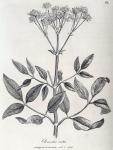
 Synonyma. Flammula Jovis. Pharm. Edinb.
Synonyma. Flammula Jovis. Pharm. Edinb.
Flammula recta. Bauh. Pin. p. 300.
Clematis sive Flammula surrecta alba. J. Bauh. Hist. vol. ii. p. 127.
Flammula Jovis surrecta. Gerard. Emac. p. 888. Park. Theat. p. 382. Raii. Hist. p. 621. sp. 4.
Clematis caule erecto, foliis pinnatis ovato-lanceolatis. Hal. Stirp. Helv. n. 1144. Flor. Aust. tab. 291. Stoerck Libell. de Flam. Jovis, tab. 1.
Class Polyandria. Ord. Polygynia. Lin. Gen. Plant. 696.
Ess. Gen. Ch. Cal. o. Petala 4—6. Sem. caudata.
Spec. Char. C. foliis pinnatis: foliolis ovato-lanceolatis integerrimis, caule erecto, floribus pentapetalis tetrapetalisque.
The root is perennial, white, and fibrous: the stalk is erect, scored, round, smooth, branched towards the top, and rises about two feet in height: the leaves are opposite, and pinnated, the pinnae are placed in pairs, and terminated by an odd one; they are all ovally lance-shaped, acute, entire, smooth, and veined. The flowers terminate the stem and branches in irregular umbels: there is no calyx: the petals are four or five, of an oval shape, and whitish colour: the filaments are numerous, ered, tapering, shorter than the petals, and terminated by the antherae, which are scored on each side: the germina are many, roundish, hairy, and support bearded styles, of the length of the stamina, and crowned with obtuse stigmata: the seeds are roundish, compressed, and attached to the styles, which appear like long feathered tails; and hence the name, sem. caudata.
This plant is a native of Hungary, Austria, and France, and flowers from June till August: it was first cultivated in England by Gerard, previous to the year 1597, and is now sufficiently known to the British gardeners. This, like some other species of the clematis, is extremely acrid, and hence the name Flammula. The recent leaves, upon being chewed, excite a burning heat of the tongue and fauces, and if retained long in the mouth, produce blisters and ulceration; but, by drying, this acrimony is considerably diminished: the flowers likewiie possess a share of acrimony, though in a less degree. The Flammula Jovis, although mentioned by Dale and some others as an external remedy, was first recommended to the attention of practitioners by Baron Stoerck in 1769, as an useful medicine in many obstinate complaints. [Although these were principally venereal, yet in ulcers, cancers, and severe headaches, not proceeding from this cause, the Flammula Jovis is said to have been likewise successful; and in his Lib. de Pulsat. p. 57. we are told of its remarkable efficacy in a case of melancholia tristissima. It generally acted as a diuretic or diaphoretic.] He published several cases of its successful exhibition, particularly in inveterate syphilitic diseases producing headaches, pains in the bones, nodes, ulcers, cutaneous affections, &c. [Vide Libell. de Flammula Jovis.]
Whether this plant really deserves the character which the Baron has thus attempted to establish, by dating its uniform success in twenty-two cases out of twenty-four, in which it was tried, rests solely upon his own authority; and it is with concern we observe, that the medical facts at Vienna are not very confidently received by the physicians in this country. It was usual for Dr. Stoerck to employ the leaves and flowers, as well as an extract prepared from the former, yet the preparation which he chiefly recommends is an infusion of two or three drams of the leaves in a pint of boiling water; of which he gave four ounces three times a day, while the powdered leaves were applied as an escharotic to the ulcers.

